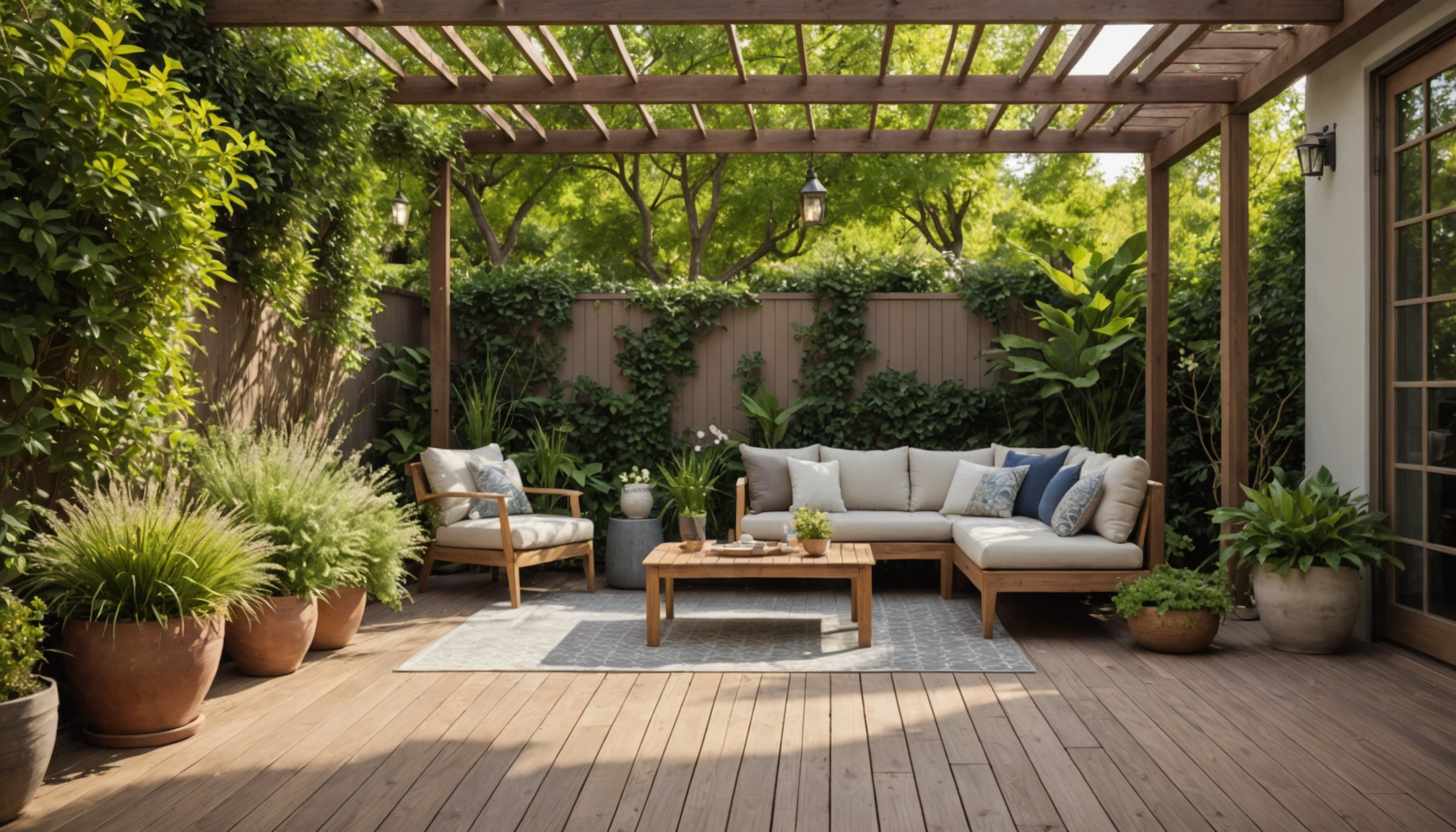Transforming your outdoor space into a personalized sanctuary begins with an inspiring and well-considered design. A crucial step when renovating your yard, it involves envisioning how you will utilize and navigate this open area, taking into account both aesthetic desires and functional needs. Attractive yet practical design will serve as the foundation for years of enjoyment, guiding subsequent decisions about plants, structures, and amenities.
Begin by assessing the current layout of your yard, noting the existing shapes, sizes, and levels. Consider what aspects you like and what needs to change, keeping in mind how you want to use the space. Do you need an area for children to play, or perhaps a tranquil spot for relaxation? Will you entertain guests frequently, necessitating a larger patio or deck area? An understanding of your priorities will help guide layout decisions and ensure that the design suits your lifestyle.
Striking a balance between open areas and private retreats enhances a yard’s versatility. Segmenting your garden can be achieved using natural dividers such as shrubbery or trellises, ensuring clear pathways and transitions between different functional zones. Incorporate eco-friendly materials like reclaimed wood or stone to add unique character and sustainability to your spaces, aligning the vertical and horizontal elements cohesively.
Modern design trends often favor clean lines and minimalist elements, but adaptability is key. Mixing in organic shapes and textures can soften the look, create dynamism, and keep the design inviting. Here, color palettes play a pivotal role; monochromatic schemes can create a seamless flow, while contrasting colors can highlight specific features or zones within the yard.
| Layout Aspect | Traditional Design | Modern Design | Eco-Friendly Design |
| Pathways | Formal, brick pathways | Concrete or sleek metal lines | Pebble or permeable surfaces |
| Plant Beds | Structured, symmetrical | Asymmetrical, focused on focal points | Native plants promoting biodiversity |
| Seating Areas | Wooden furniture with classic designs | Modern modular furniture | Reclaimed materials for benches |
| Lighting | Electric lanterns | Sleek, integrated LED lights | Solar-powered fixtures |
Security is another essential component of any yard layout. Though it might not be the most exciting aspect of design, incorporating strategic lighting and clear sightlines will deter unwanted visitors and provide peace of mind. Integrating technology with motion sensors or smart lighting solutions can enhance security while maintaining a cohesive aesthetic.
Ultimately, a well-designed yard layout is a fusion of creativity and practicality, reflecting personal tastes while addressing spatial dynamics. By thoughtfully planning each zone and considering modern trends alongside eco-conscious choices, your dream yard will not only look stunning but will also offer a versatile and sustainable environment for future enjoyment.
Choosing the right plants and materials
When selecting the right plants and materials for your yard renovation project, the key is to strike a balance between aesthetics, practicality, and sustainability. The choices you make should reflect not only your personal style but also the specific conditions of your yard, such as climate and soil type. Here’s a step-by-step guide to help you through the process:
- Analyze Your Yard’s Conditions:
- Start by assessing the sunlight exposure throughout your yard. Different plants thrive under varying light conditions—some need full sunlight, while others prefer the shade.
- Consider the soil type and quality. A soil test can provide information on pH levels and nutrient availability, guiding your plant selection and amendments needed.
- Identify any microclimates in your yard. These are areas with different climatic conditions that might be warmer, cooler, wetter, or drier than the surrounding areas.
- Selecting Plants:
- Opt for native plants as a priority. They are adapted to local climate and soil conditions, requiring less water and maintenance, and they support local biodiversity.
- Consider the plant’s growth pattern and final size. Ensure they will not outgrow the space provided and consider their seasonal changes for year-round visual interest.
- For a modern aesthetic, focus on perennial grasses and foliage plants, selecting varieties with interesting textures and colors.
- Choose Hardscape Materials:
- Select materials that complement your design style. For a contemporary yard, consider sleek materials like concrete or metal, while natural stone and wood suit a traditional or rustic look.
- Incorporate eco-friendly options such as permeable paving to reduce water runoff and recycled materials to minimize environmental impact.
- Prioritize durability and ease of maintenance. Materials should withstand weather conditions and frequent use without too much upkeep.
- Consider the Yard’s Functionality and Aesthetics:
- Design with function in mind. Ensure that plants and materials cater to specific yard activities, whether it’s entertaining, gardening, or playing.
- Use a cohesive color palette to ensure that all elements, from plants to hardscapes, work harmoniously.
- Incorporate contrasting elements to add depth and interest, such as combining lush greenery with industrial metal accents.
Taking these steps will aid in creating a vibrant and sustainable yard that aligns with modern and eco-friendly principles, enhancing your overall enjoyment of the space while benefiting the environment. Always remember, each plant and material you choose contributes to the overall atmosphere and utility of your renovated outdoor area, balancing beauty with practicality.
Installing effective lighting solutions
Effective lighting solutions play a pivotal role in enhancing both the functionality and aesthetics of your renovated yard. By thoughtfully selecting and placing lighting fixtures, you not only highlight the beauty of your outdoor space but also elevate its usability during evening hours. A well-lit yard extends the hours of enjoyment, making it possible for family gatherings, dinners, or simple relaxation under the stars.
Start by determining the specific purposes your lighting needs to serve. Ambient lighting is essential for creating a warm and inviting atmosphere, perfect for lounging or entertaining. Path lights, step lights, or low-level sconces can guide guests safely, minus the harsh glare. Look for fixtures that blend into the landscape during the day and provide the right balance of brightness at night.
Highlighting key landscape features with accent lighting can dramatically transform your yard. Use spotlights or uplights to accentuate exquisite trees, sculptures, or architectural details, turning them into focal points after dark. This not only offers an artistic touch but also helps to define spaces within your yard. Choose strategically placed ground lights or high-mounted options to bring out textures and colors that come to life under the night sky.
An eco-friendly and cost-efficient approach involves incorporating solar-powered fixtures. These are particularly advantageous in sunlit areas, removing the need for extensive wiring and reducing electricity costs. Not only are they easier to install, but they also make a sustainable choice, aligning with modern green living principles.
Integrating smart lighting solutions adds convenience and efficiency. Smart technology allows you to control your lighting remotely through mobile apps, enabling you to adjust intensity, color, or timing even when you are away from home. Adding motion sensors enhances both utility and security, as lights that activate upon detecting movement can deter potential intruders and provide illumination for unexpected late arrivals.
When planning your lighting design, always consider the overall style and theme of your yard. Whether your taste leans towards sleek, minimalist LED strips or rustic, vintage lanterns, ensure a cohesive look that complements your existing decor. Consistent design choice binds the various lighting elements together, creating a visually harmonious environment.
Lastly, remember to maintain an ecological perspective by minimizing light pollution. Install fixtures that cast light downward or use shields to direct light exactly where it’s needed. This careful consideration not only improves the atmosphere for evening enjoyment but also preserves the natural surroundings and the night sky.
By investing time and thought into installing effective lighting solutions, you augment your yard’s beauty, usability, and security. Proper lighting offers a seamless transition from indoor to outdoor living, enhancing your space’s ambiance, increasing its functionality, and ensuring it remains a welcoming retreat after the sun goes down.
Building functional outdoor structures
Integrating functional outdoor structures into your renovated yard is a transformative step that not only enhances the utility of the space but also ties together design elements for a cohesive and inviting outdoor environment. These structures can serve a variety of purposes, from providing comfortable seating and shelter to delineating different functional zones within the yard.
One of the most popular structures is the pergola. Its open framework can transform an ordinary patio into a focal point of modern elegance. A pergola offers partial shelter and is a perfect support for climbing plants like wisteria or roses, which can add vibrant color and life. To maintain a contemporary or minimalist aesthetic, opt for clean lines and neutral colors that complement the overall design of your yard. For a more traditional or rustic look, natural wood finishes can create warmth and charm.
Consider incorporating eco-friendly materials when constructing these structures. Reclaimed wood, for example, not only reduces environmental impact but also adds character and history to your yard. Similarly, metal structures made from recycled materials can offer a sleek, modern look while ensuring sustainability. These choices reflect a commitment to environmental responsibility while adding unique beauty to your outdoor space.
Functional outdoor kitchens open up a world of possibilities for entertaining and dining al fresco. When designing an outdoor kitchen, focus on the layout to ensure convenient access to utilities like water and electricity, as well as ample workspace for cooking. Stainless steel appliances are a durable and modern choice, providing a sleek aesthetic and resisting the elements. Complement these with weather-resistant countertops and storage solutions that blend seamlessly with the overall look of the yard.
A well-constructed deck or patio is another essential structure in transforming your yard. Whether you choose composite materials for their low maintenance and durability, or natural stone for its classic appeal, these areas provide a foundation for social gatherings and relaxation. Include built-in seating to maximize space efficiency and comfort, or accessorize with outdoor furniture that mirrors the style and color palette of your home’s interior for a harmonious indoor-outdoor flow.
Adding a garden shed or hobby workshop can introduce both functionality and aesthetic appeal. These structures are not only practical for storage but also offer a place to engage in gardening or DIY projects. Adorn them with climbing plants or green roofs to integrate them naturally into the landscape, enhancing both the visual and environmental aspects of your yard.
Lastly, ensure your outdoor structures contribute to the security of your yard. Incorporating features such as lockable doors for sheds or motion-detecting lights around larger structures can deter unwanted entry and provide peace of mind, allowing you to enjoy your space with confidence.
By carefully selecting and designing functional outdoor structures, you amplify the usefulness and enjoyment of your renovated yard, creating a dynamic extension of your living space that aligns with your lifestyle and design preferences. Remember, a thoughtfully planned structure is not only an investment in your property’s value but a step toward a more enjoyable and sustainable outdoor living experience.
Maintaining your renovated yard
Maintaining your renovated yard involves consistent care and attention to ensure that the essence of your transformed space remains intact while supporting a thriving ecosystem. Embrace a proactive approach by establishing a practical maintenance plan that aligns with the features of your modern yard. Regular tasks such as watering, pruning, and fertilizing should be adapted to the unique flora you selected during the renovation phase, ensuring each plant receives the specific care it requires.
Begin with an effective watering strategy. Utilizing drip irrigation systems or smart watering solutions not only promotes water efficiency but also ensures your yard receives the precise hydration it needs. These eco-friendly approaches conform to modern living standards by conserving resources while providing consistent moisture, crucial for the health of your plants.
Pruning is vital for maintaining the aesthetic appeal and health of your garden. Timely trimming of shrubs, trees, and other perennials encourages growth and keeps your yard looking organized. Focus on cutting back any dead or overgrown branches, as this will improve air circulation and prevent pest infestations, fulfilling both aesthetic and security functions within your yard.
Fertilization strategies should take into account the nutrient needs of your soil. Conduct soil tests periodically to tailor your fertilization approach, ensuring it supports continued growth. Opt for organic fertilizers that enrich your garden without introducing harmful chemicals, maintaining the eco-friendly premise of your yard.
Mulching is another crucial maintenance task. It not only retains soil moisture and suppresses weeds but also enhances soil fertility as it decomposes, promoting a healthy garden ecosystem. Choose natural, sustainable mulching materials that align with the overall style and environmental considerations of your outdoor space.
Pay attention to your yard’s hardscape elements regularly. Check for wear and tear on structures like patios, decks, and outdoor kitchens, and perform necessary repairs promptly to prevent more significant issues. Preserving these elements extends their lifespan while ensuring safety for all who enjoy your outdoor areas.
Lastly, integrate regular seasonal evaluations into your maintenance schedule. This proactive approach allows you to make necessary adjustments, such as altering plant arrangements or applying protective measures to withstand harsher weather conditions typical of cooler seasons.
Committing to a consistent and well-rounded maintenance routine ensures that your fully renovated yard remains a vibrant, functional, and environmentally responsible haven for relaxation and enjoyment. By diligently caring for each component, from plants to lighting to structures, you foster a space that remains not only visually stunning but also sustainably managed, offering ongoing joy and tranquility.
In conclusion, renovating your yard is a rewarding endeavor that requires thoughtful planning, creative execution, and diligent maintenance. Whether you’re designing your dream layout, selecting plants and materials, installing lighting, adding structures, or upkeeping your space, each step plays a crucial role in enhancing the beauty and functionality of your outdoor sanctuary. By embracing eco-friendly practices and modern design principles, you can transform your yard into a sustainable and charming extension of your home that reflects your personal style and enriches your lifestyle for years to come.


